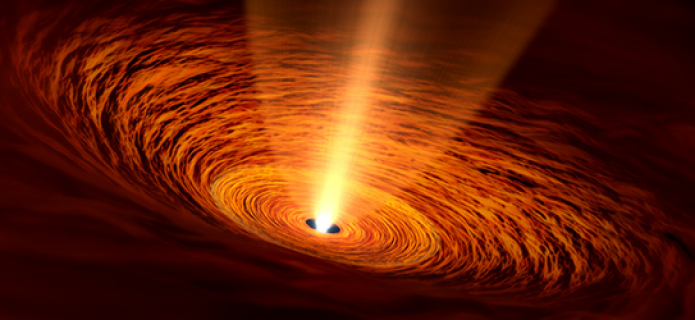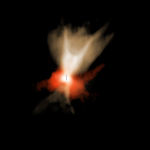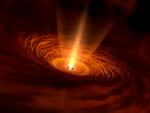ALMA Spots Baby Star’s Growing Blanket
Researchers using the Atacama Large Millimeter/submillimeter Array (ALMA) have made the first direct observations delineating the gas disk around a baby star from the infalling gas envelope. This finding fills an important missing piece in our understanding of the early phases of stellar evolution.
A team led by Yusuke Aso (a graduate student at the University of Tokyo) and Nagayoshi Ohashi (a professor at the Subaru Telescope, National Astronomical Observatory of Japan) observed the baby star named TMC-1A located 450 light years away from us, in the constellation Taurus (the Bull). TMC-1A is a protostar, a star still in the process of forming. Large amounts of gas still surround TMC-1A.
Stars form in dense gas clouds. Baby stars grow by taking in the surrounding gas, like a fetus receiving nutrition from the mother’s placenta. In this process, gas cannot flow directly into the star. Instead it first accumulates and forms a disk around the star, and then the disk feeds into the star. However, it is still unknown when in the process of star formation this disk appears and how it evolves. Lack of sensitivity and resolution in radio observations has made it difficult to observe these phenomena.
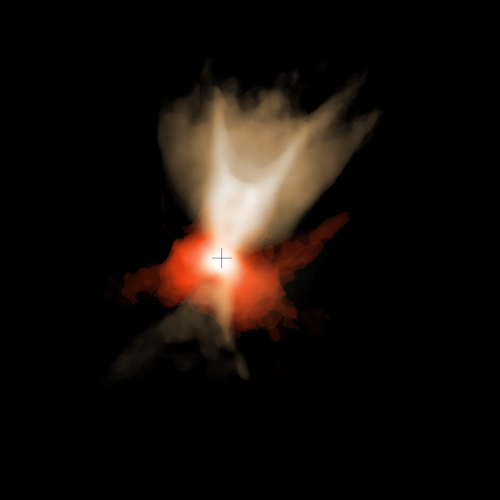
Composite image of TMC-1A observations. Dense gas seen around the star with ALMA is shown in red. ALMA also spotted outflowing gas from the star, a feature often seen around baby stars; this outflowing gas is shown in white. The position of the star is indicated with a cross. The image without the cross sign can be downloaded from here. Credit: ALMA (ESO/NAOJ/NRAO), Aso et al.
“The disks around young stars are the places where planets will be formed,” said Aso, the lead author of the paper that appeared in the Astrophysical Journal. “To understand the formation mechanism of a disk, we need to differentiate the disk from the outer envelope precisely and pinpoint the location of its boundary.”
Using ALMA, the team directly observed the boundary between the inner rotating disk and the outer infalling envelope with high accuracy for the first time. Since gas from the outer envelope is continuously falling into the disk, it had been difficult to identify the transition region in previous studies. In particular, the tenuous but high speed gas in rotating disks is not easy to see. But ALMA has enough sensitivity to highlight such a component and illustrate the speed and distribution of gas in the disk very precisely. This enabled the team to distinguish the disk from the infalling envelope.

Gas motion around TMC-1A. The red color indicates gas is moving away from us while the blue color is coming closer to us. Credit: ALMA (ESO/NAOJ/NRAO), Aso et al.
The team found that the boundary between the disk and envelope is located 90 astronomical units from the central baby star. This distance is three times longer than the orbit of Neptune, the outermost planet in the Solar System. The observed disk obeys Keplerian rotation: the material orbiting closer to the central star revolves faster than material further out.
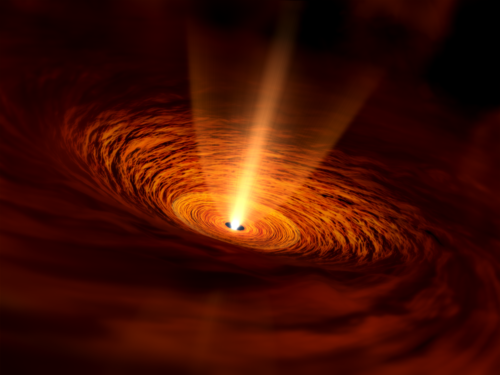
Artist’s impression of the baby star TMC-1A. The star is located in the center and surrounded by a rotating gas disk. Gas is infalling to the disk from the envelope further out. Credit: NAOJ
The high-sensitivity observations provided other important information about the object. From detailed measurement of the rotation speed, the research team could calculate that the mass of the baby star is 0.68 times the mass of the Sun. The team also determined the gas infall rate to be a millionth of the mass of the Sun per year, with a speed of 1 km per second. Gravity causes gas to fall towards the central baby star, but the measured speed is much less than the free-fall speed. Something must be slowing the gas down. The researchers suspect that a magnetic field around the baby star might be what is slowing the gas.
“We expect that as the baby star grows, the boundary between the disk and the infall region moves outward,” said Aso. “We are sure that future ALMA observations will reveal such evolution.”
These observational results were published as Aso et al. "ALMA Observations of the Transition from Infall Motion to Keplerian Rotation around the Late-phase Protostar TMC-1A " in the Astrophysical Journal.
Artist’s impression video of the baby star TMC-1A. Credit: NAOJ
Additional information
The Atacama Large Millimeter/submillimeter Array (ALMA), an international astronomy facility, is a partnership of the European Organisation for Astronomical Research in the Southern Hemisphere (ESO), the U.S. National Science Foundation (NSF) and the National Institutes of Natural Sciences (NINS) of Japan in cooperation with the Republic of Chile. ALMA is funded by ESO on behalf of its Member States, by NSF in cooperation with the National Research Council of Canada (NRC) and the Ministry of Science and Technology (MOST) in Taiwan and by NINS in cooperation with the Academia Sinica (AS) in Taiwan and the Korea Astronomy and Space Science Institute (KASI).
ALMA construction and operations are led by ESO on behalf of its Member States; by the National Radio Astronomy Observatory (NRAO), managed by Associated Universities, Inc. (AUI), on behalf of North America; and by the National Astronomical Observatory of Japan (NAOJ) on behalf of East Asia. The Joint ALMA Observatory (JAO) provides the unified leadership and management of the construction, commissioning and operation of ALMA.
Contacts
Valeria Foncea
Education and Public Outreach Officer
Joint ALMA Observatory
Santiago, Chile
Tel: +56 2 467 6258
Cell: +56 9 75871963
Email: [email protected]
Masaaki Hiramatsu
Education and Public Outreach Officer, NAOJ Chile
Observatory
Tokyo, Japan
Tel: +81 422 34 3630
E-mail: [email protected]
Richard Hook
Public Information Officer, ESO
Garching bei München, Germany
Tel: +49 89 3200 6655
Cell: +49 151 1537 3591
Email: [email protected]
Charles E. Blue
Public Information Officer
National Radio Astronomy Observatory
Charlottesville, Virginia, USA
Tel: +1 434 296 0314
Cell: +1 202 236 6324
E-mail: [email protected]
